February 16 - 22, 2014: Issue 150
Mona Vale Hospital’s Golden Jubilee – 1964 – 2014 – Fifty Years as a Community Hospital
From the Beginning
In October 1831, the land on which the hospital now stands, previously known as Sheep Station Hill, was granted to James and Elizabeth Jenkins. In 1900 Mrs Jenkins died and bequeathed her estate to the Salvation Army. However there was considerable litigation in regard to the bequest and the land was not transferred to this charitable organisation until 1904. Perhaps the start of several disputes over this site.
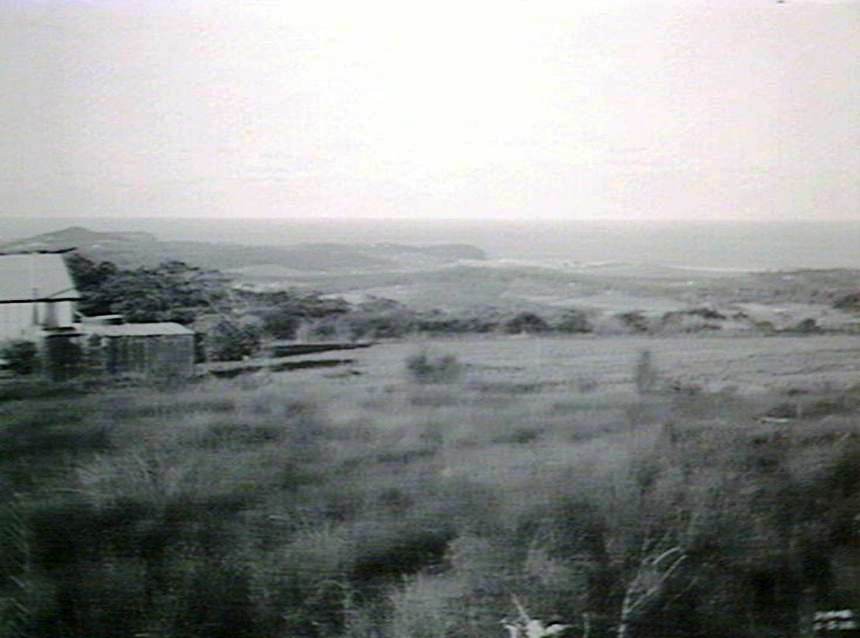
Mona Vale Road, looking towards Mona Vale, from crest of ridge, 6/1925. Government Printing Office 1 - 25349, courtesy State Library of NSW.
Ownership of the land continued with the organisation until November 3, 1955 at which time the land was resumed by the Labor Government of the day for the purposes of a Public Hospital and the title placed in the name of Manly District Hospital to be subsequently transferred to Mona Vale District Hospital.
Historically 19 August 1958 was the first day the hospital was founded when a public meeting of some 500 people met at Brookvale Theatre to elect a Board of Directors.
In 1961 the Government called for tenders to build the new hospital. In its first annual report in 1963 the Board acknowledged the great participation of the local community as far back as 1950. A participation that has continued through the life of the hospital. In the second week of May 1961 a tender for the building of Mona Vale Hospital was let and the building was completed in 1964. In March 1963 the Board appointed F.R. James as Chief Executive Officer and Mary Henlen as Marton.
Community initiated and originally constructed as a 152 bed acute hospital, Mona Vale Hospital was officially opened on 22nd February 1964 by the then Minister for Health the Hon W Sheehan. The 1982 AGM Agenda notes that at the time of opening the public supported the Board with ‘generous donations to establish a kiosk, library and extra facilities for the patients.
On 23 March 1964 one ward was opened for the admission of patients along with the Accident and Emergency. In 1975 the 43 bed Paediatric Unit was opened on Level 6 replacing the staff canteen.
In 1976, the hospital’s role was extended to encompass community health services and to develop further a comprehensive range of clinical services and facilities. It is a teaching hospital of the University of Sydney and has full accreditation with the Australian Council on Healthcare Standards.
Throughout the years the hospital has seen an emphasis on Community Health with services such as Mental Health, Dental and Dental education, Audiology, Geriatric and Rehabilitation, Adolescent Counselling, Lifestyle Health Education programs and Speech Pathology.
Source: MVH Board Agenda 1982
Milestones - Moments along the way
The Hospital Board will be pleased to receive applications from girls 17 years and over, who desire to make nursing their career. Those interested should address their inquiries to Mona Vale Hospital, PO Box 61, Post Office, Mona Vale. (1962)
Maryanne Shopland (first nurse educator at Hospital) opened the first ward and the first patient had a broken leg. They did not have equipment to stabilise so Maryanne and other nurse ran down to beach and filled pillowcases with sand.
The number of people aged 70 years and over in Manly Warringah in 1986 exceeded 12,600. In less than four years it is anticipated that this number will increase to about 15,000. John Ducker AO. Chairman Board of Directors in 1982.
The Jubilee of Mona Vale Hospital - 50 YEARS, 2014 - Contributed by Marg Stephens
In the late 1950's, Premier Rob Askin was lobbied (successfully)by my mother Connie Stephens, & others of the community, re the pressing need for a public hospital within the then Warringah Shire.
In 1958, resultant of a public meeting, 6 elected residents and 4 government appointees formed the Board of Directors of the Mona Vale District Hospital. By 1961, site selected & foundations underway for the planned hospital, my father Tom Stephens (then Chief Engineer/Town Planner Warringah Shire Council), was asked to be Honorary civil Engineer for the project Meanwhile the enthusiastic community galvanized and the Bayview/Church Point hospital Auxiliary (& later others) was formed.
At our family home in Church Point, a meeting had been convened to discuss and ascertain interest in the formation of a Mona Vale Hospital “Younger Set”.
1963 and Miss Mary Henlen, then the Matron of Manly District Hospital, was appointed inaugural “Matron” of the Mona Vale District Hospital and Dr Neil Orr – medical Superintendent.
Though the hospital was still under construction, the visionary Miss Henlen proceeded to recruit (local) girls hoping to embark on their 4 years general nursing training. Due to earlier association with St George Hospital, in 1963 the first 5 girls were accepted to do their Preliminary nursing training @ this hospital in Kogarah. These students were Wendy (Sylvia) Mortimer, Denise Douglas, Jenny Wilson, Amanda Muras & Margaret Stephens.
By the end of that year, Mona Vale Hospital was at “lock-up” stage, we and the St George nurse groups who followed us, arrived at Mona Vale and moved into the new Nurses' Home. Our first tasks were to prepare the first ward to open for patients – making beds, cleaning lockers etc.
What a refreshing change we encountered as “Mona Vale” nurses. Gone were the tired cramped rooms, verandah beds and “nightingale” wards. Sea and golf-course views. Built-in robes, nurses' stations and huge day-room. No perilous boiling water pan sterilizer – Now a pan-washer and steam sterilizer. Starched aprons/collars and black stockings were replaced by green/white striped dresses, tartan capes and flesh-coloured nylons. “Sisters” veils were obsolete
Miss Henlen fostered an honour system and we were provided a Nurses' Home key - unusual for that time. Travelling time was allowed for those attending functions “in town” and further. Senior nurses were permitted to “move out”, many to share flats and some returning to family homes.
Most progressive was the introduction of “Team Nursing” which enabled us to look after the whole patient while mentored and to learn skills to the level of our understanding and capabilities. Having experienced the contrasting job assignment system of St George Hospital (and others), we were particularly appreciative of the merits of Team Nursing.
The old system incorporated stretches of time entailing menial tasks, such as 'pan-rounds' & scrubbing, tray-setting, “fluid balance charts etc – progressing to simple dressings, enemas etc.
Nurses' rosters were also considered revolutionary and terms of night duty not in great batches of months, rather 7 on and 4 off. I also recall one Christmas when everyone was rostered on but only for 6 hours and time of choice.
Miss Henlen's strategy incorporated inviting the welcome transference of student nurses from Manly, Sydney & Royal North Shore Hospitals and Psychiatric trained nurses wishing to undergo their “general” nurse training at Mona Vale. Newly graduated “sisters” were also recruited from various other facilities. This ensured a broad range of experience & skills on our ward “teams” at the outset.
Mona Vale was one of the first hospitals to accept married women and male students.
With a view to Mona Vale Graduates more easily qualifying abroad, particularly in Commonwealth countries, our training included terms in Maternity and at North Ryde Psychiatric hospital (from which students were also welcomed on exchange with Mona Vale). Recognising the success of “Team Nursing” at Mona Vale, 3 graduates were subsequently invited to introduce this method at Sydney Hospital.
Elected General Secretary of the New South Wales Nurses' Association, Mary Henlen left Mona Vale Hospital (where she had also been a Board Member) about 1968 initiating and effecting great improvements in nurse education and a driving force behind the transference to secondary institutions. Major reforms in nursing conditions and pay were largely attributed to her efforts on their behalf.
Mona Vale Hospital Auxiliary
Source - Interview with Eileen Gordon
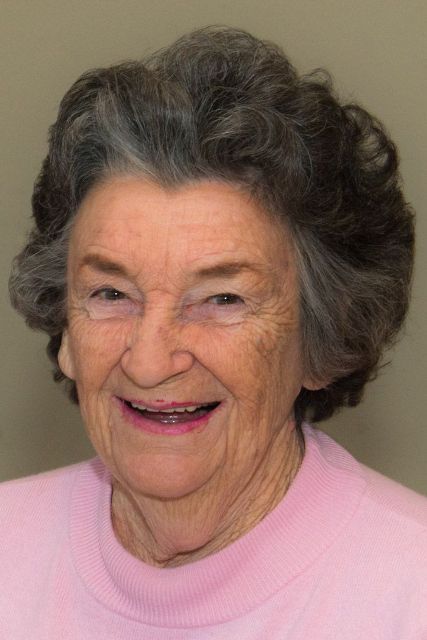 The Mona Vale Hospital Auxiliary fund-raises to purchase equipment for
Mona Vale Hospital. Our fund-raising activities include running the Kiosk at the
Hospital seven days a week, monthly stalls at the Hospital and Pittwater Place
as well as monthly BBQs at Bunnings, Narrabeen. In addition, there are
occasional Fashion Parades, Garden Shows, High-Teas and anything else that will
raise funds. Over the past 2 years, the Auxiliary has purchased electric beds,
new lockers, overbed tables, visitors chairs for all wards, plus ecg machines,
self-locking medication trolleys, dressing trolleys, physiotherapy equipment,
blockout blinds for western windows, axis child-health cots, surgical equipment,
humidifiers, and new carpet for our beautiful chapel.
The Mona Vale Hospital Auxiliary fund-raises to purchase equipment for
Mona Vale Hospital. Our fund-raising activities include running the Kiosk at the
Hospital seven days a week, monthly stalls at the Hospital and Pittwater Place
as well as monthly BBQs at Bunnings, Narrabeen. In addition, there are
occasional Fashion Parades, Garden Shows, High-Teas and anything else that will
raise funds. Over the past 2 years, the Auxiliary has purchased electric beds,
new lockers, overbed tables, visitors chairs for all wards, plus ecg machines,
self-locking medication trolleys, dressing trolleys, physiotherapy equipment,
blockout blinds for western windows, axis child-health cots, surgical equipment,
humidifiers, and new carpet for our beautiful chapel.
Prior to the opening of the Hospital, the several Auxiliaries in the area had been lobbying for a hospital to be built at Mona Vale. In the first Annual Report of the Hospital, the Board of Directors reported on the great participation and financial support contributed by the Hospital Auxiliaries.
In anticipation of the opening, the Auxiliaries established the Combined Auxiliary, made up of two representatives from each of the five auxiliaries for the purpose of establishing and running a Hospital Kiosk. When the Hospital opened, SO DID the Kiosk!
The Mona Vale Hospital Kiosk was established in March, 1964, using a six hundred pound loan from the Hospital Board. Ten months later —31st January, 1965— the Kiosk showed a trading surplus of nine hundred and fourteen pounds, fourteen shillings and ninepence. The set-up loan was then repaid to the Hospital Board.
The Kiosk later moved to the present location (near main entrance), which was built and equipped with funds raised by the Auxiliaries. The Kiosk continues to be maintained from Kiosk funds. The aim is to provide a service for staff, patients and visitors while keeping our charges as low as possible. The Auxiliary staffs the kiosk with volunteers, oversees its maintenance and management and allocates any profits to purchasing equipment for the hospital.
In earlier years, most of the fund-raising was done with large annual fetes in the Hospital grounds, concerts and dinners. With changing times, we have found that stalls, raffles, fashion parades and individual Charity days seem to be the best way to involve our very supportive community. With our enlarged membership, we are able to have a stall in the Hospital foyer once a month, on the third Friday of the month. There is a stall in Avalon for Mother’s Day and Father’s Day, occasional stalls in Pittwater Place and a stall outside Memorial Hall when there is an election - Council, State or Federal.
At the end of its last financial year in June 2013, the Auxillary raised $295,916. As in previous years the Auxillary used these funds to purchase items for the Hospital. This included beds and cots for Paediatrics, ECG machine for ECU, CT Flouroscopy for Radiology. During the year items were purchased for almost every part of the Hospital.
Since the opening of the Hospital in 1964 the Auxiliary has donated $3,365,000 to Mona Vale Hospital. - Financials for Eileen Gordon 13Feb 2104
Eileen Gordon, Past President of Mona Vale Hospital Auxiliary. "The Jubilee is a celebration of 50 years of the Hospital care for members of our community"
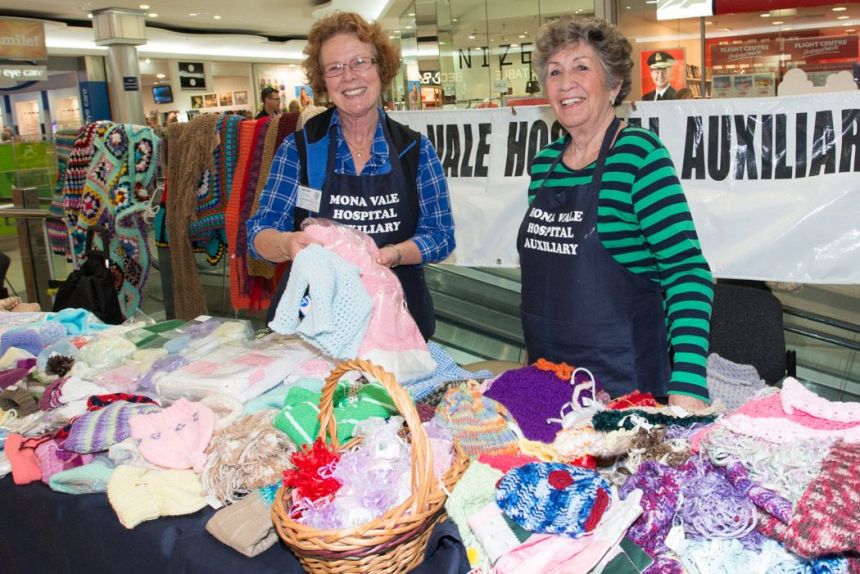
In Text Eileen Gordon - Above: The Front Line. Norma Moran and Yvonne Parsons doing the hard work. Pictures by Michael Mannington.
Mona Vale Hospital Younger Set
In 1961, Connie Stephens, a member of the Mona Vale Hospital Auxiliary put a notice in the Manly Daily inviting young people of the Northern Beaches to a meeting at her Bayview home to start The Mona Vale Hospital Younger Set.
The new group was formed for two purposes: firstly to raise funds for the hospital, which was about to be built, and to provide a social outlet for the young people in the area.
It didn’t take long for the aims to reverse themselves. Having fun became a very important focus for the young membership. That being said a healthy cheque was handed over to the hospital at the end of each financial year.
Money was raised by holding a variety of functions and activities. These included parties, car trials, theatre parties, picnic days, open air movie nights, pyjama parties, western nights, weekend parties at the old Portland Hotel and trips to the Bathurst car races.
A very popular event was the BBQ at Patonga when many Younger Set members would board the old “West Head” ferry skippered by Ted Steck. Ted would pick up members at Church Point in the late afternoon and return them about midnight after a BBQ and a movie at the old Patonga Picture theatre.
Monthly Meetings were initially held at the Overy’s house in Bakers Rd at Bayview but then moved onto a room at the hospital.
Younger Set members also rostered at the hospital kiosk on weekends.
Fun was the order of the day and many life-long friendships were formed as well as a long list of marriages.
It seemed a simpler time and while the functions were certainly not alcohol free there were never any problems with drugs or gate crashers.
The Younger Set diminished in the 70’s as people married and had families and social life in general changed.
Contribution by Ian and Coleen Lee
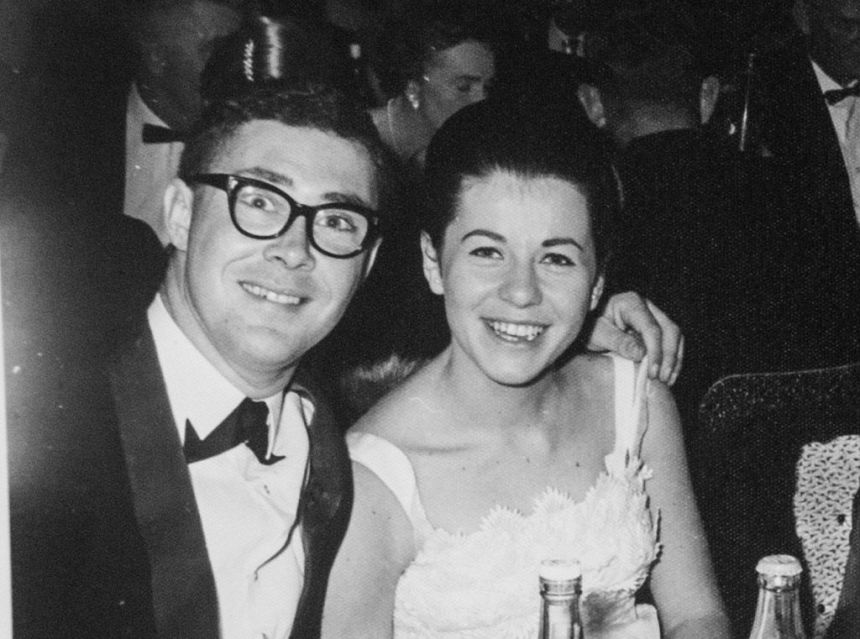
Ian and Coleen Lee at a 1960's Younger Set ball. Photo: Ian Lee
Rotary and Mona Vale Hospital
The Rotary Club of Pittwater has been actively contributing to the Hospital for at least 40 years. Alan Hicks (Hospital CEO) was also a member and then President of the Rotary Club of Pittwater for some time. The playground and then the playground refurbishment was an initiative of Pittwater Rotary. Treasurer Bob Barrack tells that donations by Rotary to Palliative Care in the last few years are in excess of $60,000. Palliative Care has been the major beneficiary of the Rotary Spring Concert which has been held each year at the Warriewood Cinemas Grand Theatre attracting over 300 people and featuring Jane Rutter for the last 2 years. Source ROTARY website
Palliative Care at Mona Vale Hospital
On 14th November the Rotary Clubs of Pittwater and Terrey Hills officially handed over the proceeds from their fundraising efforts in support of extensions and upgrades to the Palliative Care Centre at Mona Vale Hospital. The funds, totalling $70,000, were presented by representatives of the two clubs at a ceremony at Pittwater RSL Club.
Over the last 18 months Pittwater Rotary has nominated as its major community project raising funds for the expansion and upgrade of the facilities of the Northern Beaches Palliative Care Centre on the grounds of Mona Vale Hospital. The outcomes of this project are a greater local awareness of the importance of palliative care, and funds raised to the amount of $60,000. Terry Hills Rotary raised $15,000 by nominating the palliative care building project as the major beneficiary from their annual golf day at the Terrey Hills Golf Club.
In March 2010, The Rotary Club of Pittwater identified the Palliative Care Centre project as a significant challenge, a great need in the community and one which Northern Beaches residents and businesses would eagerly support. Several club members had experienced first-hand the support of local palliative care specialists and so appreciated the potential value Rotary could add by raising the awareness of the need for additional palliative care support in the area and to raise additional funds for the building program. With the funds raised by Rotary clubs and other sources, the building project is scheduled to commence in the beginning of 2013.
Pittwater, Narrabeen and Terrey Hills Rotary clubs express their deepest appreciation to our community for the invaluable support of more than 50 local businesses, organisations, clubs and individuals in aid of palliative care generally, and the Mona Vale Palliative Care Centre in particular. It is a long and continuing association and with the possibility of a Hospice in the future it is likely to remain significant.
Source Rotary Club of Pittwater's Press Release
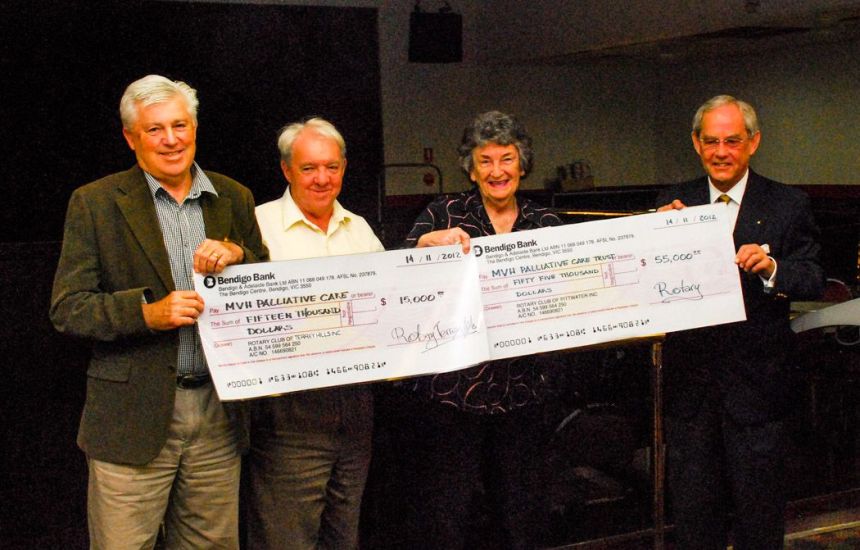
John Power (Terrey Hills Rotary), Dr Peter Moore (Palliative Care Service), Eileen Gordon (Mona Vale Hospital Auxiliary) and Hans Carlborg (Pittwater Rotary). 2012. Donation cheques totalling $75,000 for Palliative Car. Photo Pittwater Rotary
Incidentals – samples of reports during first few years
- Collected/Collated by A.J.G. - Pittwater Online History Files 2011-2014
DIARY date: June 21--luncheon at Jonah's, Whale Beach, to aid the Mona Vale, Bayview, and Church Point District Hospital Auxiliary. SOCIAL. (1961, June 14). The Australian Women's Weekly(1933 - 1982), p. 16. Retrieved from http://nla.gov.au/nla.news-article47493365
Australia's quietest and most advanced hospital is being built at Mona Vale, in Sydney's northern suburbs. As well as incorporating latest sound-proofing techniques, the hospital will maintain contact with staff by small electronic devices carried in the pocket. The hospital, scheduled to be opened early next year, will be a patient's paradise. Each room will have a sweeping view of Mona Vale beach and miles of picturesque coastline. The backdrop will be the rippling blue Pacific Ocean. Patients — who will have their own telephones — will be getting scenic features that would cost tourists many pounds more at luxury beach resorts. The hospital will be surrounded by thousands of square feet of lush green lawn. And if that is not enough, right beside it is the Mona Vale golf course. Employment in the district will receive a wonderful boost. Two hundred local girls will be recruited as nurses, and many others for various hospital departments. IN NEW SOUTH WALES THIS WEEK. (1963, October 16). The Canberra Times (ACT : 1926 - 1995), p. 2. Retrieved from http://nla.gov.au/nla.news-article104271618
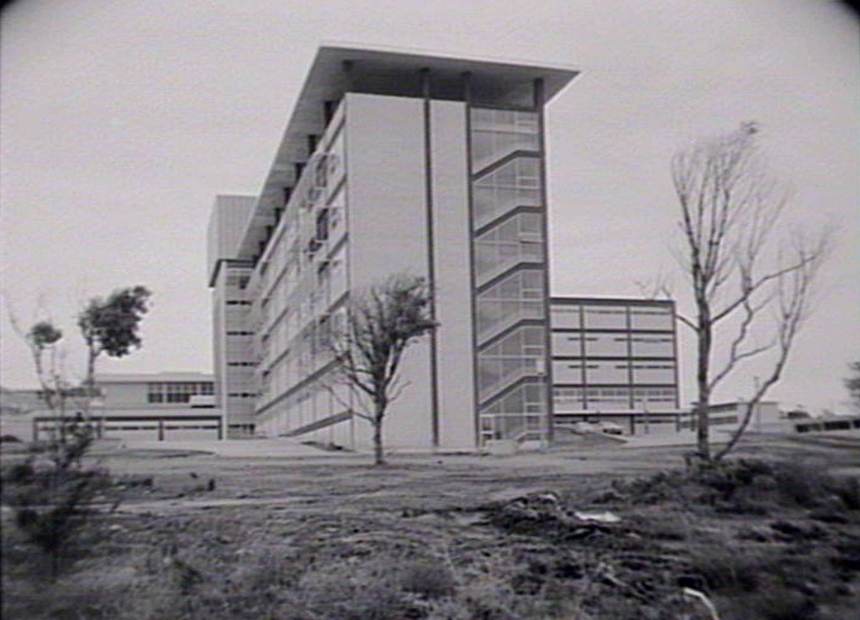
New hospital at Mona Vale, 9/12/1963. Government Printing Office 2 - 25143, courtesy State Library of NSW.
Historian in hospital
The famous Australian war historian and scholar, Dr. C. E. W. Bean, is seriously ill in Mona Vale Hospital, Sydney. Dr. Bean, 84, is perhaps best known for his Official History of Australia in the First World War. As Official War Correspondent, he landed at Gallipoli with the 1st Battalion on April 25, 1915. Historian in hospital. (1964, July 22). The Canberra Times(ACT : 1926 - 1995), p. 1. Retrieved from http://nla.gov.au/nla.news-article105834604
Dr. Charles Edwin Woodrow Bean and his wife moved from Linfield to Collaroy in 1956, to another house named Clifton. Early in 1964, aged 84, Bean was transferred to the Concord Repatriation General Hospital, and died there on 30 August 1968.
Illustrated: Perhaps the best example of a revolution in nurses' uniforms is at the very new Mona Vale Hospital, opened in the Sydney beach suburb last month. There Matron M. Henlen has designed new uniforms for her whole staff. "Starting with a new hospital is the ideal way to intro-duce a new look," said Miss Henlen. "I didn't have to fight tradition, like most matrons who try to bring in a new uniform."
The nurses at Mona Vale have green-and-white-striped dresses with short sleeves and soft flat collars and cuffs, nylon stockings, and light brown shoes.
"I chose green for the stripe as it looks so fresh and is in keeping with the rich green grass surrounding thehospital," said Miss Henlen. "It's also a very new color for nurses' uniforms; most of them are made in blues or greys."
And something else: the matron and the sisters don't wear veils. The matron just wears a neat white poplin uniform and the sisters wear the same style in light blue.
"It's my personal theory that veils could help to spread bacteria," said the matron. "And unless veils are arranged perfectly they look untidy. The sisters have caps to put on when they need them, but they wear veils only for formal occasions at the hospital, never in the wards."
The nurses don't wear aprons. All the food preparation and domestic duties are done by a catering and cleaning staff.
"This is an American idea that has been adopted in a few Australian hospitals," said Miss Henlen, "so that the nurses can spend all their time looking after the patients. Because the women on the catering and cleaning staff move about in the wards, I designed a bright and practical uniform for them, too. Most of our patients and all of our visitors have remarked how pleasantly different our new uniforms are."
AT MONA VALE HOSPITAL, Sydney's newest, the nurses don't do the cleaning and so have no need for aprons. From left: cleaning-staff member Miss Orzlowski, NurseMelandre, Matron Henlen, Sister Oldfield, and catering-staff member Mrs. Archbold. Hospital says: Goodbye to starch and black stockings. (1964, April 29). The Australian Women's Weekly (1933 - 1982), p. 4. Retrieved from http://nla.gov.au/nla.news-article51775576
Photo: “COMPUTERS will only do what you tell them to do," said Gillian Stumbles, who programmes C.S.I.R.O. research data for their big new computer in Sydney. "The computer won't think. It does as you instruct, even if you make a stupid mistake." Gill, 27, is a South African who came back to Australia two years ago after she married Kevin Stumbles in London, where he was studying singing. He is chief radiographer at Mona Vale Hospital, N.S.W., and they live in Mona Vale. A "brain" that doesn't think. (1965, March 31). The Australian Women's Weekly (1933 - 1982), p. 15. Retrieved from http://nla.gov.au/nla.news-article51397228
Photo: The new Mona Vale Hospital, near Sydney. Extensive use was made of terrazzo flooring in its construction, notably in the entrance foyer, corridors and wards. A special conductive terrazzo was used for the floors of the hospital's four operating theatres. Homes and building Sidewalk supervisor Woden reservoir nearly ready. (1967, November 6). The Canberra Times (ACT : 1926 - 1995), p. 10. Retrieved from http://nla.gov.au/nla.news-article106980910
NEW POLICE INSPECTOR APPOINTED - Inspector George E. Westerberg is the newly appointed Inspector of the Bourke Police Sub-District which has its headquarters at Bourke. He replaces Inspector Bill Parry who was transferred to Grafton towards the end of last year. Inspector Westerberg and his wife Phyllis arrived in Bourke on 17th December to take up their appointment here. Serving in the one area for such a considerable time, inspector Westerberg became particularly well known on the Northern Beach area of the city. Naturally he was associated with many organisations during that time. He was a Director on the Board of the Mona Vale District Hospital. He was also President of the Warringah Branch of the Road Safety Council. For some years he was Secretary of the Warringah and Manly A. and H. Society which stages the Annual Brookvale Show. NEW POLICE INSPECTOR APPOINTED. (1969, January 24).Western Herald (Bourke, NSW : 1887 - 1970), p. 3. Retrieved from http://nla.gov.au/nla.news-article104126892
Mona Vale Hospital’s Golden Jubilee – 1964 – 2014 – Fifty Years as a Community Hospital by Michael Mannington, 2014.